Comprehensive Analysis of Uber's Business Strategy and Environment
VerifiedAdded on 2023/01/04
|15
|4749
|27
Report
AI Summary
This report provides a comprehensive analysis of Uber's business strategy, examining the impact of the macro environment using PESTEL analysis and the Stakeholders matrix. It delves into the internal environment and capabilities through SWOT, McKinsey's 7S, and VRIO models. Furthermore, it evaluates competitive forces using Porter's Five Forces model and interprets strategic planning approaches. The report covers Uber's mission, vision, and objectives, and explores the strategic capabilities and various frameworks used to understand and assess the company's operations within the transportation and delivery market. The analysis considers political, economic, social, technological, environmental, ethical, and legal factors, along with stakeholder interests, strengths, weaknesses, opportunities, and threats. The study also highlights the application of the McKinsey 7S model and SWOT analysis to evaluate Uber's internal environment and its strategic capabilities.
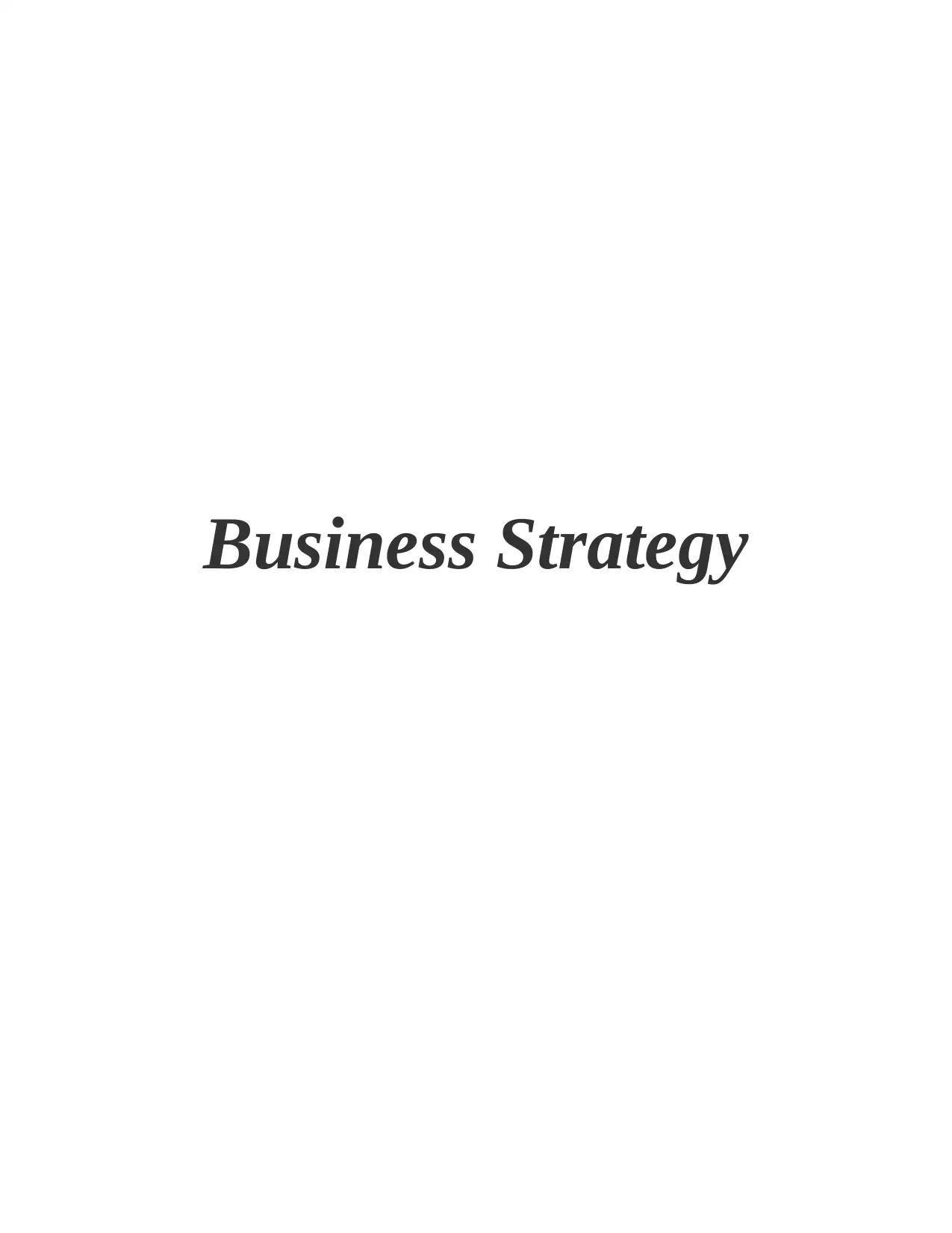
Business Strategy
Paraphrase This Document
Need a fresh take? Get an instant paraphrase of this document with our AI Paraphraser
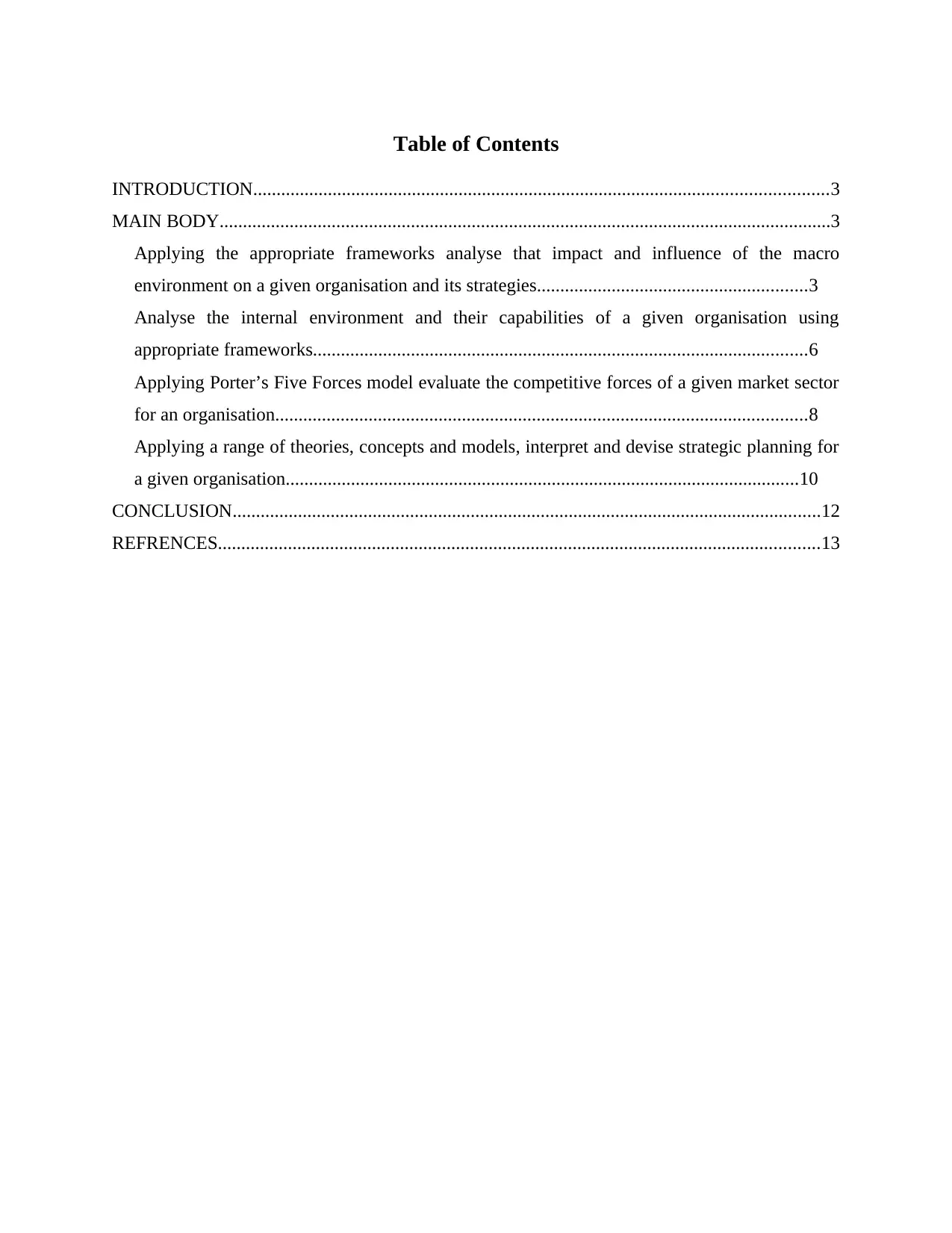
Table of Contents
INTRODUCTION...........................................................................................................................3
MAIN BODY...................................................................................................................................3
Applying the appropriate frameworks analyse that impact and influence of the macro
environment on a given organisation and its strategies..........................................................3
Analyse the internal environment and their capabilities of a given organisation using
appropriate frameworks..........................................................................................................6
Applying Porter’s Five Forces model evaluate the competitive forces of a given market sector
for an organisation..................................................................................................................8
Applying a range of theories, concepts and models, interpret and devise strategic planning for
a given organisation..............................................................................................................10
CONCLUSION..............................................................................................................................12
REFRENCES.................................................................................................................................13
INTRODUCTION...........................................................................................................................3
MAIN BODY...................................................................................................................................3
Applying the appropriate frameworks analyse that impact and influence of the macro
environment on a given organisation and its strategies..........................................................3
Analyse the internal environment and their capabilities of a given organisation using
appropriate frameworks..........................................................................................................6
Applying Porter’s Five Forces model evaluate the competitive forces of a given market sector
for an organisation..................................................................................................................8
Applying a range of theories, concepts and models, interpret and devise strategic planning for
a given organisation..............................................................................................................10
CONCLUSION..............................................................................................................................12
REFRENCES.................................................................................................................................13
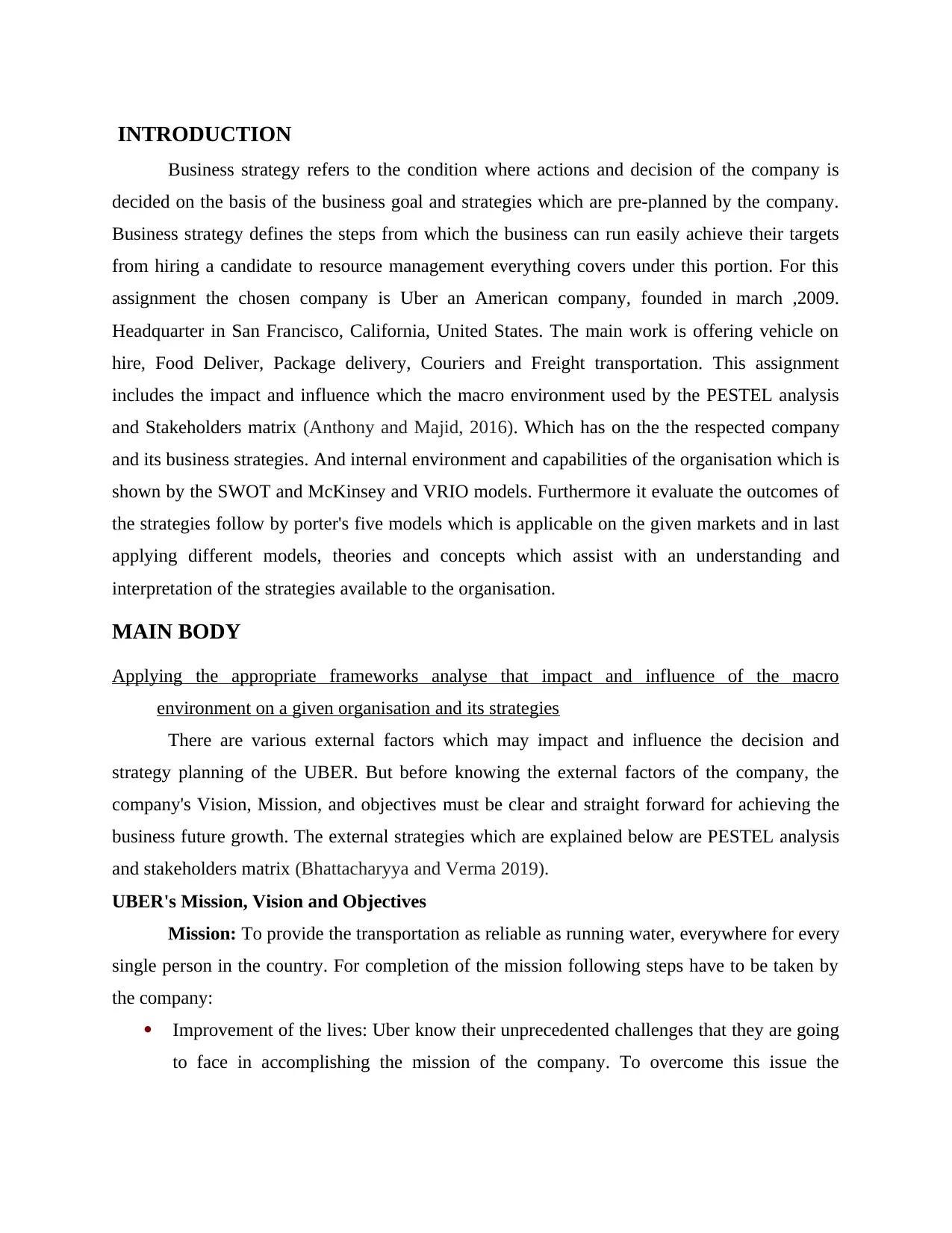
INTRODUCTION
Business strategy refers to the condition where actions and decision of the company is
decided on the basis of the business goal and strategies which are pre-planned by the company.
Business strategy defines the steps from which the business can run easily achieve their targets
from hiring a candidate to resource management everything covers under this portion. For this
assignment the chosen company is Uber an American company, founded in march ,2009.
Headquarter in San Francisco, California, United States. The main work is offering vehicle on
hire, Food Deliver, Package delivery, Couriers and Freight transportation. This assignment
includes the impact and influence which the macro environment used by the PESTEL analysis
and Stakeholders matrix (Anthony and Majid, 2016). Which has on the the respected company
and its business strategies. And internal environment and capabilities of the organisation which is
shown by the SWOT and McKinsey and VRIO models. Furthermore it evaluate the outcomes of
the strategies follow by porter's five models which is applicable on the given markets and in last
applying different models, theories and concepts which assist with an understanding and
interpretation of the strategies available to the organisation.
MAIN BODY
Applying the appropriate frameworks analyse that impact and influence of the macro
environment on a given organisation and its strategies
There are various external factors which may impact and influence the decision and
strategy planning of the UBER. But before knowing the external factors of the company, the
company's Vision, Mission, and objectives must be clear and straight forward for achieving the
business future growth. The external strategies which are explained below are PESTEL analysis
and stakeholders matrix (Bhattacharyya and Verma 2019).
UBER's Mission, Vision and Objectives
Mission: To provide the transportation as reliable as running water, everywhere for every
single person in the country. For completion of the mission following steps have to be taken by
the company:
Improvement of the lives: Uber know their unprecedented challenges that they are going
to face in accomplishing the mission of the company. To overcome this issue the
Business strategy refers to the condition where actions and decision of the company is
decided on the basis of the business goal and strategies which are pre-planned by the company.
Business strategy defines the steps from which the business can run easily achieve their targets
from hiring a candidate to resource management everything covers under this portion. For this
assignment the chosen company is Uber an American company, founded in march ,2009.
Headquarter in San Francisco, California, United States. The main work is offering vehicle on
hire, Food Deliver, Package delivery, Couriers and Freight transportation. This assignment
includes the impact and influence which the macro environment used by the PESTEL analysis
and Stakeholders matrix (Anthony and Majid, 2016). Which has on the the respected company
and its business strategies. And internal environment and capabilities of the organisation which is
shown by the SWOT and McKinsey and VRIO models. Furthermore it evaluate the outcomes of
the strategies follow by porter's five models which is applicable on the given markets and in last
applying different models, theories and concepts which assist with an understanding and
interpretation of the strategies available to the organisation.
MAIN BODY
Applying the appropriate frameworks analyse that impact and influence of the macro
environment on a given organisation and its strategies
There are various external factors which may impact and influence the decision and
strategy planning of the UBER. But before knowing the external factors of the company, the
company's Vision, Mission, and objectives must be clear and straight forward for achieving the
business future growth. The external strategies which are explained below are PESTEL analysis
and stakeholders matrix (Bhattacharyya and Verma 2019).
UBER's Mission, Vision and Objectives
Mission: To provide the transportation as reliable as running water, everywhere for every
single person in the country. For completion of the mission following steps have to be taken by
the company:
Improvement of the lives: Uber know their unprecedented challenges that they are going
to face in accomplishing the mission of the company. To overcome this issue the
⊘ This is a preview!⊘
Do you want full access?
Subscribe today to unlock all pages.

Trusted by 1+ million students worldwide
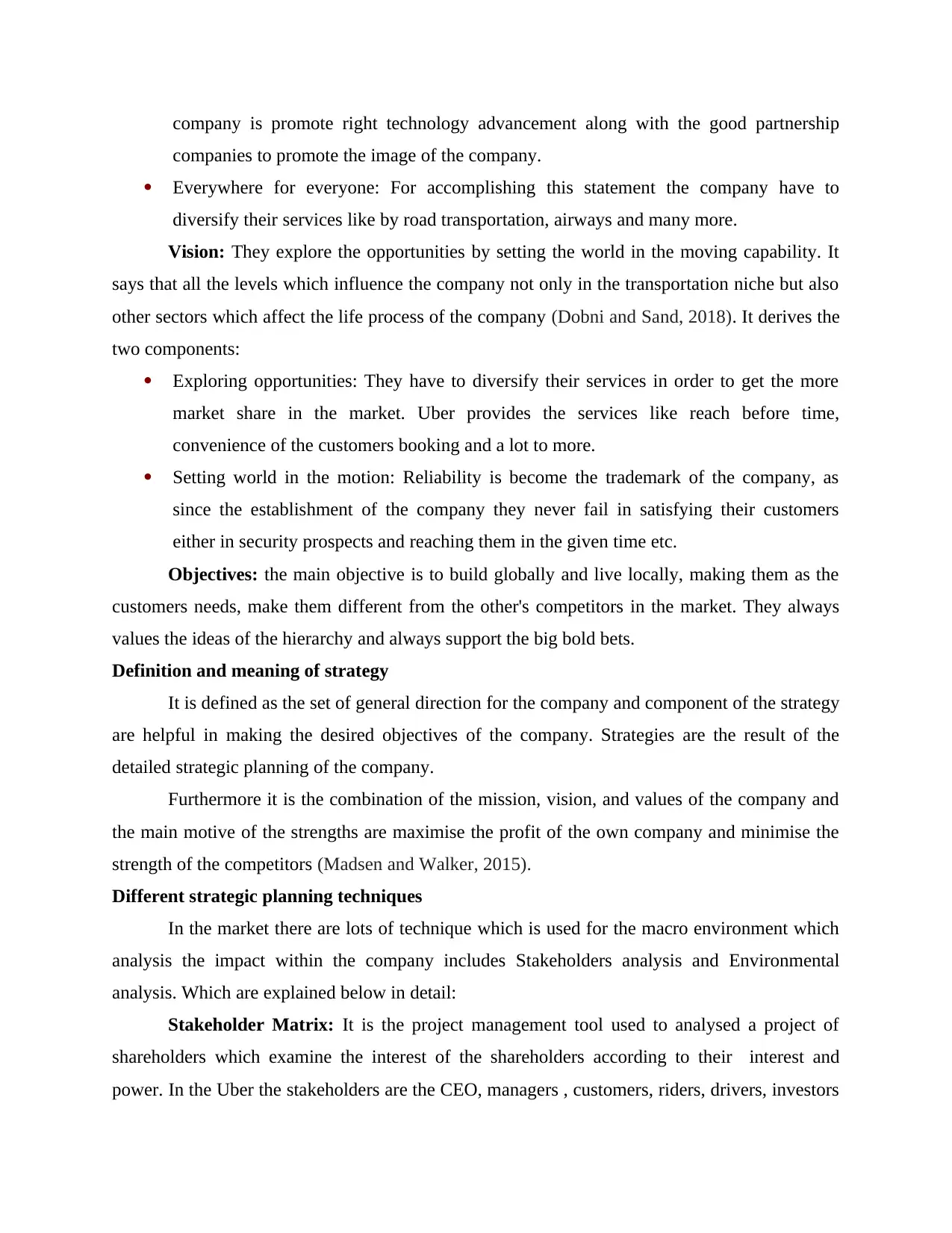
company is promote right technology advancement along with the good partnership
companies to promote the image of the company.
Everywhere for everyone: For accomplishing this statement the company have to
diversify their services like by road transportation, airways and many more.
Vision: They explore the opportunities by setting the world in the moving capability. It
says that all the levels which influence the company not only in the transportation niche but also
other sectors which affect the life process of the company (Dobni and Sand, 2018). It derives the
two components:
Exploring opportunities: They have to diversify their services in order to get the more
market share in the market. Uber provides the services like reach before time,
convenience of the customers booking and a lot to more.
Setting world in the motion: Reliability is become the trademark of the company, as
since the establishment of the company they never fail in satisfying their customers
either in security prospects and reaching them in the given time etc.
Objectives: the main objective is to build globally and live locally, making them as the
customers needs, make them different from the other's competitors in the market. They always
values the ideas of the hierarchy and always support the big bold bets.
Definition and meaning of strategy
It is defined as the set of general direction for the company and component of the strategy
are helpful in making the desired objectives of the company. Strategies are the result of the
detailed strategic planning of the company.
Furthermore it is the combination of the mission, vision, and values of the company and
the main motive of the strengths are maximise the profit of the own company and minimise the
strength of the competitors (Madsen and Walker, 2015).
Different strategic planning techniques
In the market there are lots of technique which is used for the macro environment which
analysis the impact within the company includes Stakeholders analysis and Environmental
analysis. Which are explained below in detail:
Stakeholder Matrix: It is the project management tool used to analysed a project of
shareholders which examine the interest of the shareholders according to their interest and
power. In the Uber the stakeholders are the CEO, managers , customers, riders, drivers, investors
companies to promote the image of the company.
Everywhere for everyone: For accomplishing this statement the company have to
diversify their services like by road transportation, airways and many more.
Vision: They explore the opportunities by setting the world in the moving capability. It
says that all the levels which influence the company not only in the transportation niche but also
other sectors which affect the life process of the company (Dobni and Sand, 2018). It derives the
two components:
Exploring opportunities: They have to diversify their services in order to get the more
market share in the market. Uber provides the services like reach before time,
convenience of the customers booking and a lot to more.
Setting world in the motion: Reliability is become the trademark of the company, as
since the establishment of the company they never fail in satisfying their customers
either in security prospects and reaching them in the given time etc.
Objectives: the main objective is to build globally and live locally, making them as the
customers needs, make them different from the other's competitors in the market. They always
values the ideas of the hierarchy and always support the big bold bets.
Definition and meaning of strategy
It is defined as the set of general direction for the company and component of the strategy
are helpful in making the desired objectives of the company. Strategies are the result of the
detailed strategic planning of the company.
Furthermore it is the combination of the mission, vision, and values of the company and
the main motive of the strengths are maximise the profit of the own company and minimise the
strength of the competitors (Madsen and Walker, 2015).
Different strategic planning techniques
In the market there are lots of technique which is used for the macro environment which
analysis the impact within the company includes Stakeholders analysis and Environmental
analysis. Which are explained below in detail:
Stakeholder Matrix: It is the project management tool used to analysed a project of
shareholders which examine the interest of the shareholders according to their interest and
power. In the Uber the stakeholders are the CEO, managers , customers, riders, drivers, investors
Paraphrase This Document
Need a fresh take? Get an instant paraphrase of this document with our AI Paraphraser
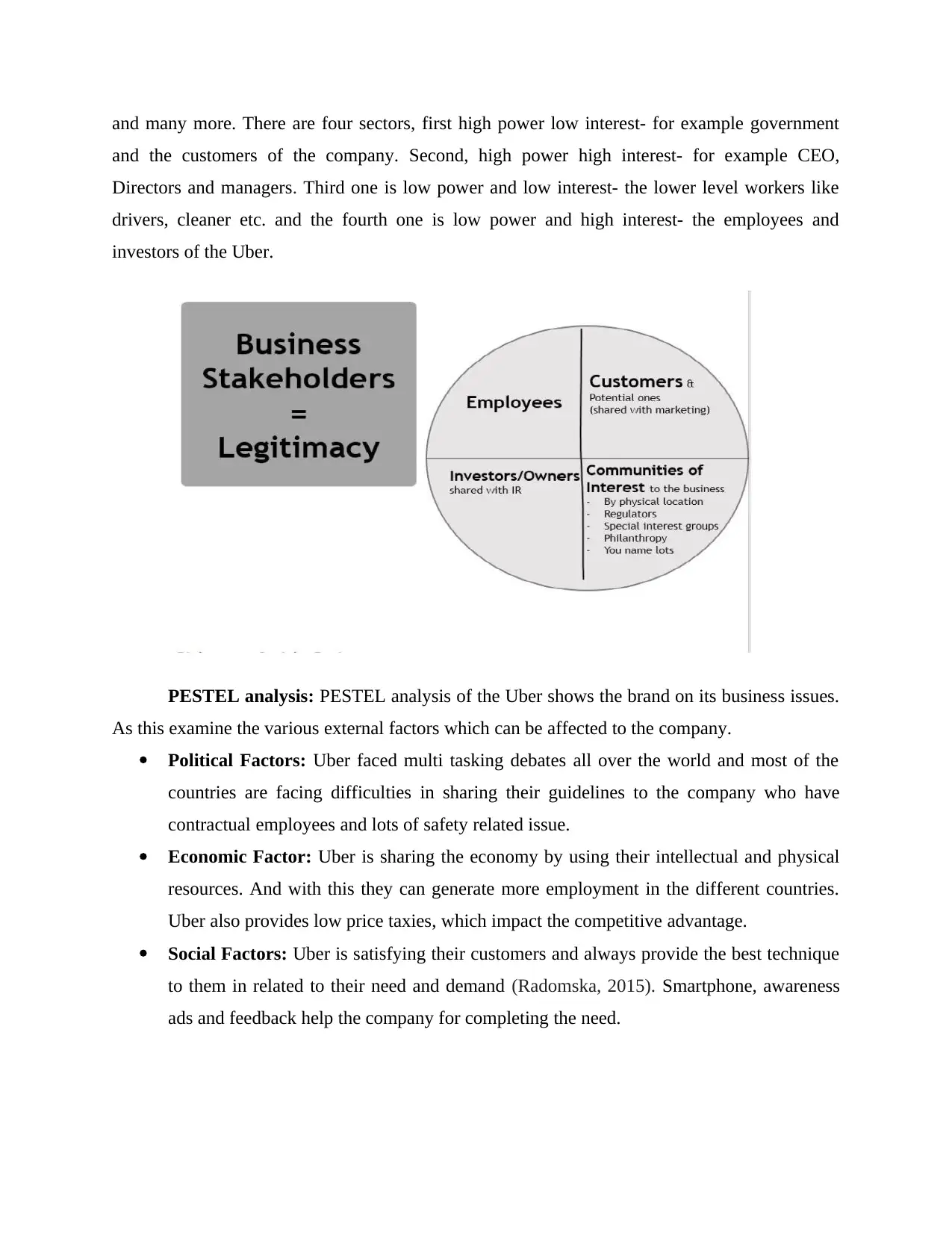
and many more. There are four sectors, first high power low interest- for example government
and the customers of the company. Second, high power high interest- for example CEO,
Directors and managers. Third one is low power and low interest- the lower level workers like
drivers, cleaner etc. and the fourth one is low power and high interest- the employees and
investors of the Uber.
PESTEL analysis: PESTEL analysis of the Uber shows the brand on its business issues.
As this examine the various external factors which can be affected to the company.
Political Factors: Uber faced multi tasking debates all over the world and most of the
countries are facing difficulties in sharing their guidelines to the company who have
contractual employees and lots of safety related issue.
Economic Factor: Uber is sharing the economy by using their intellectual and physical
resources. And with this they can generate more employment in the different countries.
Uber also provides low price taxies, which impact the competitive advantage.
Social Factors: Uber is satisfying their customers and always provide the best technique
to them in related to their need and demand (Radomska, 2015). Smartphone, awareness
ads and feedback help the company for completing the need.
and the customers of the company. Second, high power high interest- for example CEO,
Directors and managers. Third one is low power and low interest- the lower level workers like
drivers, cleaner etc. and the fourth one is low power and high interest- the employees and
investors of the Uber.
PESTEL analysis: PESTEL analysis of the Uber shows the brand on its business issues.
As this examine the various external factors which can be affected to the company.
Political Factors: Uber faced multi tasking debates all over the world and most of the
countries are facing difficulties in sharing their guidelines to the company who have
contractual employees and lots of safety related issue.
Economic Factor: Uber is sharing the economy by using their intellectual and physical
resources. And with this they can generate more employment in the different countries.
Uber also provides low price taxies, which impact the competitive advantage.
Social Factors: Uber is satisfying their customers and always provide the best technique
to them in related to their need and demand (Radomska, 2015). Smartphone, awareness
ads and feedback help the company for completing the need.
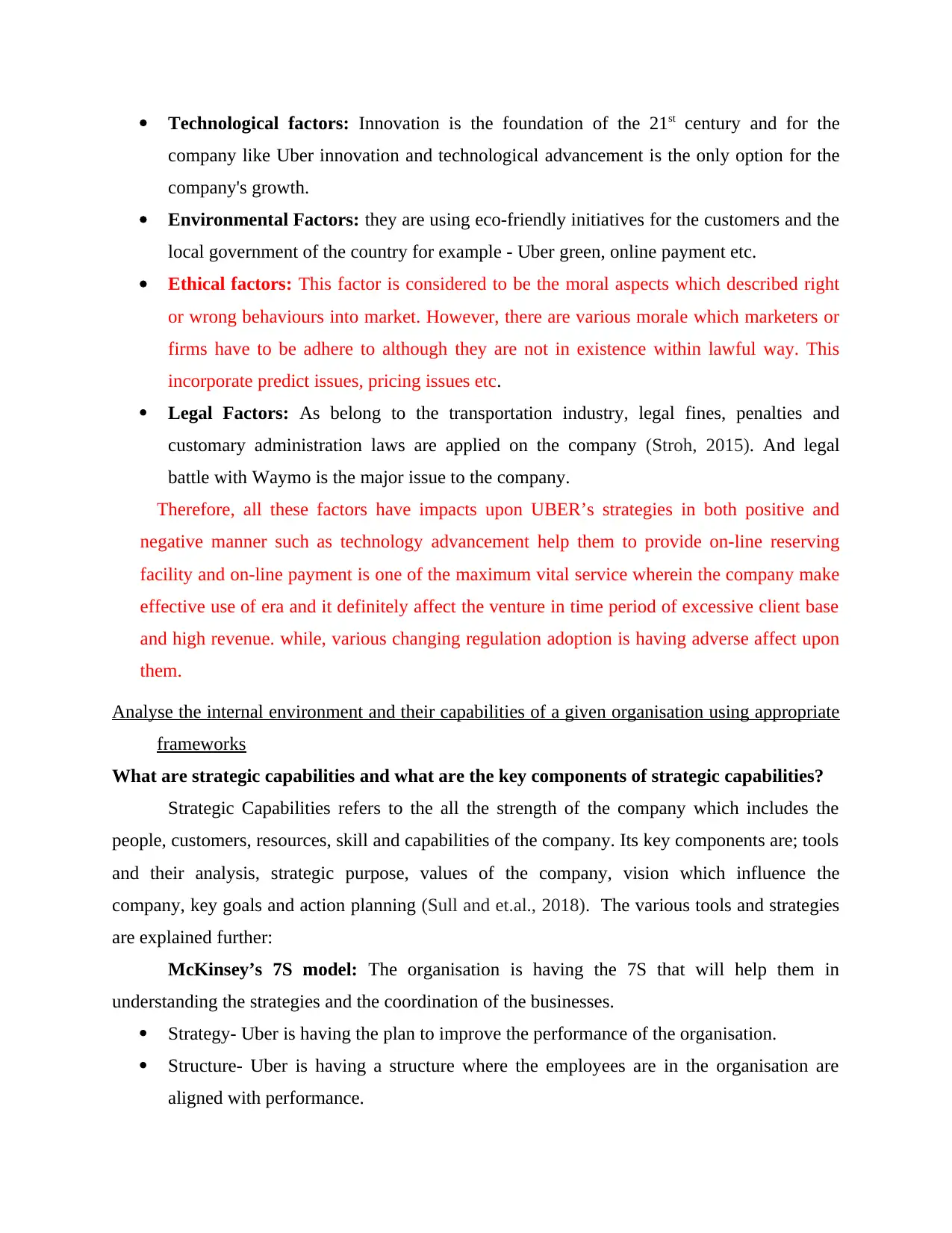
Technological factors: Innovation is the foundation of the 21st century and for the
company like Uber innovation and technological advancement is the only option for the
company's growth.
Environmental Factors: they are using eco-friendly initiatives for the customers and the
local government of the country for example - Uber green, online payment etc.
Ethical factors: This factor is considered to be the moral aspects which described right
or wrong behaviours into market. However, there are various morale which marketers or
firms have to be adhere to although they are not in existence within lawful way. This
incorporate predict issues, pricing issues etc.
Legal Factors: As belong to the transportation industry, legal fines, penalties and
customary administration laws are applied on the company (Stroh, 2015). And legal
battle with Waymo is the major issue to the company.
Therefore, all these factors have impacts upon UBER’s strategies in both positive and
negative manner such as technology advancement help them to provide on-line reserving
facility and on-line payment is one of the maximum vital service wherein the company make
effective use of era and it definitely affect the venture in time period of excessive client base
and high revenue. while, various changing regulation adoption is having adverse affect upon
them.
Analyse the internal environment and their capabilities of a given organisation using appropriate
frameworks
What are strategic capabilities and what are the key components of strategic capabilities?
Strategic Capabilities refers to the all the strength of the company which includes the
people, customers, resources, skill and capabilities of the company. Its key components are; tools
and their analysis, strategic purpose, values of the company, vision which influence the
company, key goals and action planning (Sull and et.al., 2018). The various tools and strategies
are explained further:
McKinsey’s 7S model: The organisation is having the 7S that will help them in
understanding the strategies and the coordination of the businesses.
Strategy- Uber is having the plan to improve the performance of the organisation.
Structure- Uber is having a structure where the employees are in the organisation are
aligned with performance.
company like Uber innovation and technological advancement is the only option for the
company's growth.
Environmental Factors: they are using eco-friendly initiatives for the customers and the
local government of the country for example - Uber green, online payment etc.
Ethical factors: This factor is considered to be the moral aspects which described right
or wrong behaviours into market. However, there are various morale which marketers or
firms have to be adhere to although they are not in existence within lawful way. This
incorporate predict issues, pricing issues etc.
Legal Factors: As belong to the transportation industry, legal fines, penalties and
customary administration laws are applied on the company (Stroh, 2015). And legal
battle with Waymo is the major issue to the company.
Therefore, all these factors have impacts upon UBER’s strategies in both positive and
negative manner such as technology advancement help them to provide on-line reserving
facility and on-line payment is one of the maximum vital service wherein the company make
effective use of era and it definitely affect the venture in time period of excessive client base
and high revenue. while, various changing regulation adoption is having adverse affect upon
them.
Analyse the internal environment and their capabilities of a given organisation using appropriate
frameworks
What are strategic capabilities and what are the key components of strategic capabilities?
Strategic Capabilities refers to the all the strength of the company which includes the
people, customers, resources, skill and capabilities of the company. Its key components are; tools
and their analysis, strategic purpose, values of the company, vision which influence the
company, key goals and action planning (Sull and et.al., 2018). The various tools and strategies
are explained further:
McKinsey’s 7S model: The organisation is having the 7S that will help them in
understanding the strategies and the coordination of the businesses.
Strategy- Uber is having the plan to improve the performance of the organisation.
Structure- Uber is having a structure where the employees are in the organisation are
aligned with performance.
⊘ This is a preview!⊘
Do you want full access?
Subscribe today to unlock all pages.

Trusted by 1+ million students worldwide
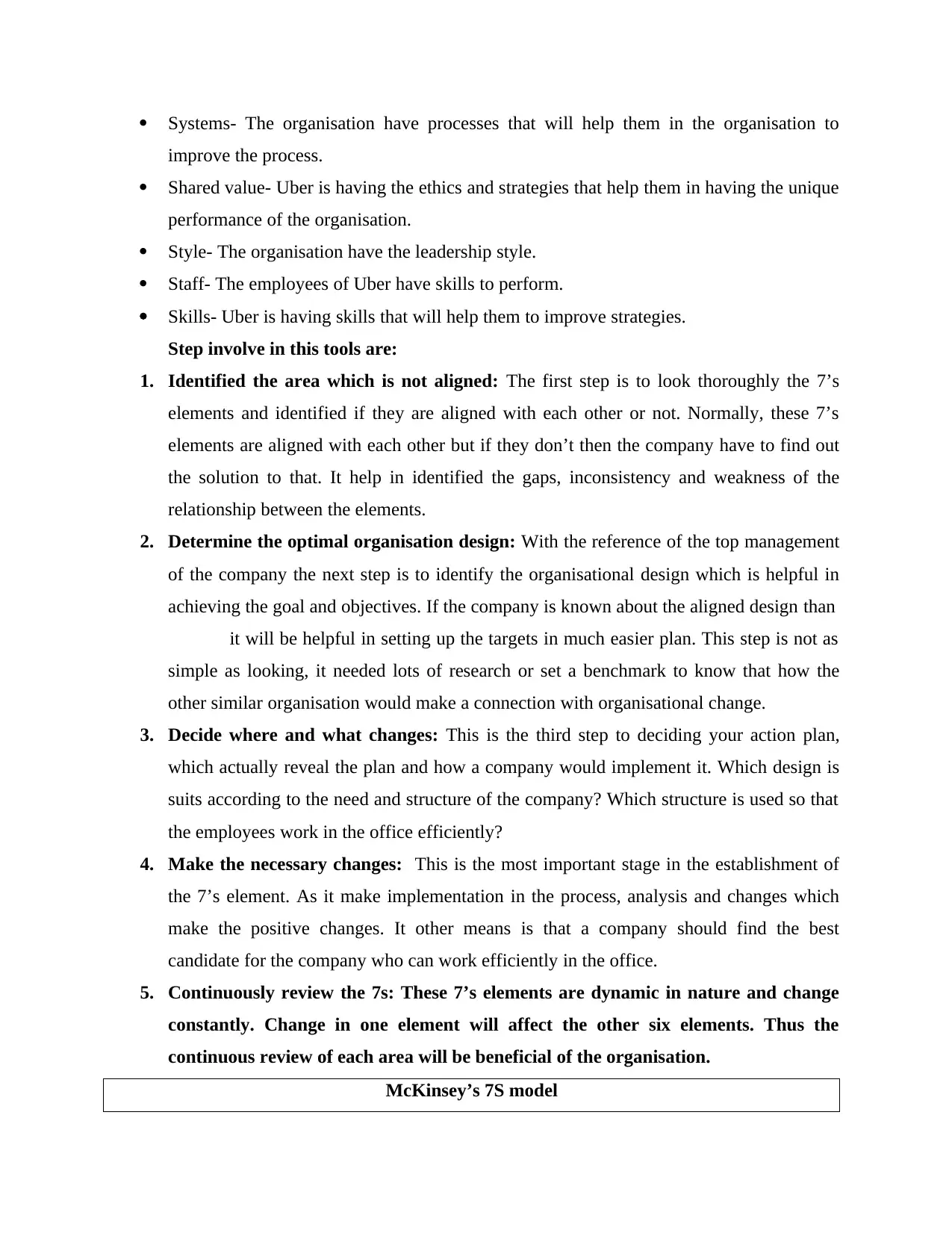
Systems- The organisation have processes that will help them in the organisation to
improve the process.
Shared value- Uber is having the ethics and strategies that help them in having the unique
performance of the organisation.
Style- The organisation have the leadership style.
Staff- The employees of Uber have skills to perform.
Skills- Uber is having skills that will help them to improve strategies.
Step involve in this tools are:
1. Identified the area which is not aligned: The first step is to look thoroughly the 7’s
elements and identified if they are aligned with each other or not. Normally, these 7’s
elements are aligned with each other but if they don’t then the company have to find out
the solution to that. It help in identified the gaps, inconsistency and weakness of the
relationship between the elements.
2. Determine the optimal organisation design: With the reference of the top management
of the company the next step is to identify the organisational design which is helpful in
achieving the goal and objectives. If the company is known about the aligned design than
it will be helpful in setting up the targets in much easier plan. This step is not as
simple as looking, it needed lots of research or set a benchmark to know that how the
other similar organisation would make a connection with organisational change.
3. Decide where and what changes: This is the third step to deciding your action plan,
which actually reveal the plan and how a company would implement it. Which design is
suits according to the need and structure of the company? Which structure is used so that
the employees work in the office efficiently?
4. Make the necessary changes: This is the most important stage in the establishment of
the 7’s element. As it make implementation in the process, analysis and changes which
make the positive changes. It other means is that a company should find the best
candidate for the company who can work efficiently in the office.
5. Continuously review the 7s: These 7’s elements are dynamic in nature and change
constantly. Change in one element will affect the other six elements. Thus the
continuous review of each area will be beneficial of the organisation.
McKinsey’s 7S model
improve the process.
Shared value- Uber is having the ethics and strategies that help them in having the unique
performance of the organisation.
Style- The organisation have the leadership style.
Staff- The employees of Uber have skills to perform.
Skills- Uber is having skills that will help them to improve strategies.
Step involve in this tools are:
1. Identified the area which is not aligned: The first step is to look thoroughly the 7’s
elements and identified if they are aligned with each other or not. Normally, these 7’s
elements are aligned with each other but if they don’t then the company have to find out
the solution to that. It help in identified the gaps, inconsistency and weakness of the
relationship between the elements.
2. Determine the optimal organisation design: With the reference of the top management
of the company the next step is to identify the organisational design which is helpful in
achieving the goal and objectives. If the company is known about the aligned design than
it will be helpful in setting up the targets in much easier plan. This step is not as
simple as looking, it needed lots of research or set a benchmark to know that how the
other similar organisation would make a connection with organisational change.
3. Decide where and what changes: This is the third step to deciding your action plan,
which actually reveal the plan and how a company would implement it. Which design is
suits according to the need and structure of the company? Which structure is used so that
the employees work in the office efficiently?
4. Make the necessary changes: This is the most important stage in the establishment of
the 7’s element. As it make implementation in the process, analysis and changes which
make the positive changes. It other means is that a company should find the best
candidate for the company who can work efficiently in the office.
5. Continuously review the 7s: These 7’s elements are dynamic in nature and change
constantly. Change in one element will affect the other six elements. Thus the
continuous review of each area will be beneficial of the organisation.
McKinsey’s 7S model
Paraphrase This Document
Need a fresh take? Get an instant paraphrase of this document with our AI Paraphraser
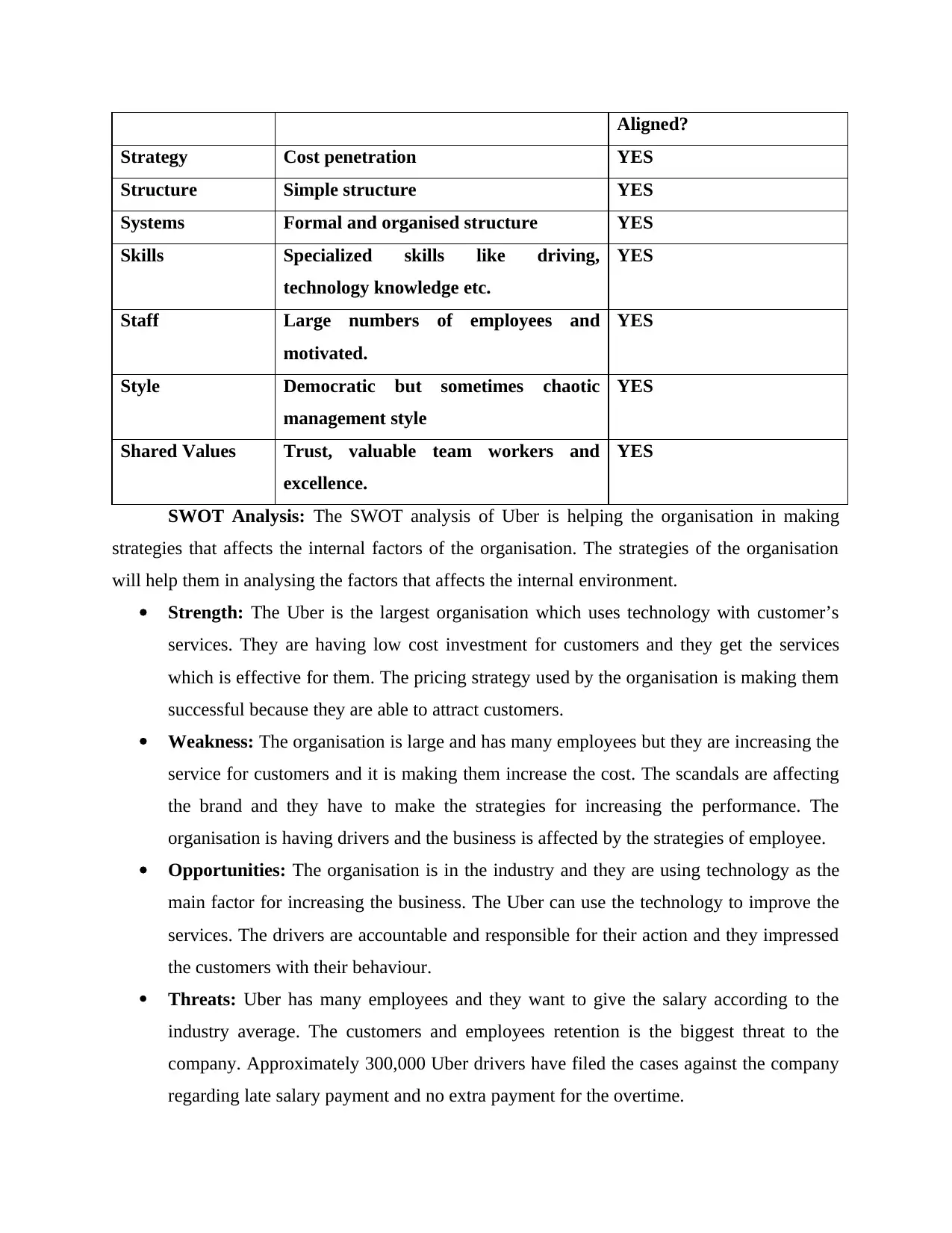
Aligned?
Strategy Cost penetration YES
Structure Simple structure YES
Systems Formal and organised structure YES
Skills Specialized skills like driving,
technology knowledge etc.
YES
Staff Large numbers of employees and
motivated.
YES
Style Democratic but sometimes chaotic
management style
YES
Shared Values Trust, valuable team workers and
excellence.
YES
SWOT Analysis: The SWOT analysis of Uber is helping the organisation in making
strategies that affects the internal factors of the organisation. The strategies of the organisation
will help them in analysing the factors that affects the internal environment.
Strength: The Uber is the largest organisation which uses technology with customer’s
services. They are having low cost investment for customers and they get the services
which is effective for them. The pricing strategy used by the organisation is making them
successful because they are able to attract customers.
Weakness: The organisation is large and has many employees but they are increasing the
service for customers and it is making them increase the cost. The scandals are affecting
the brand and they have to make the strategies for increasing the performance. The
organisation is having drivers and the business is affected by the strategies of employee.
Opportunities: The organisation is in the industry and they are using technology as the
main factor for increasing the business. The Uber can use the technology to improve the
services. The drivers are accountable and responsible for their action and they impressed
the customers with their behaviour.
Threats: Uber has many employees and they want to give the salary according to the
industry average. The customers and employees retention is the biggest threat to the
company. Approximately 300,000 Uber drivers have filed the cases against the company
regarding late salary payment and no extra payment for the overtime.
Strategy Cost penetration YES
Structure Simple structure YES
Systems Formal and organised structure YES
Skills Specialized skills like driving,
technology knowledge etc.
YES
Staff Large numbers of employees and
motivated.
YES
Style Democratic but sometimes chaotic
management style
YES
Shared Values Trust, valuable team workers and
excellence.
YES
SWOT Analysis: The SWOT analysis of Uber is helping the organisation in making
strategies that affects the internal factors of the organisation. The strategies of the organisation
will help them in analysing the factors that affects the internal environment.
Strength: The Uber is the largest organisation which uses technology with customer’s
services. They are having low cost investment for customers and they get the services
which is effective for them. The pricing strategy used by the organisation is making them
successful because they are able to attract customers.
Weakness: The organisation is large and has many employees but they are increasing the
service for customers and it is making them increase the cost. The scandals are affecting
the brand and they have to make the strategies for increasing the performance. The
organisation is having drivers and the business is affected by the strategies of employee.
Opportunities: The organisation is in the industry and they are using technology as the
main factor for increasing the business. The Uber can use the technology to improve the
services. The drivers are accountable and responsible for their action and they impressed
the customers with their behaviour.
Threats: Uber has many employees and they want to give the salary according to the
industry average. The customers and employees retention is the biggest threat to the
company. Approximately 300,000 Uber drivers have filed the cases against the company
regarding late salary payment and no extra payment for the overtime.
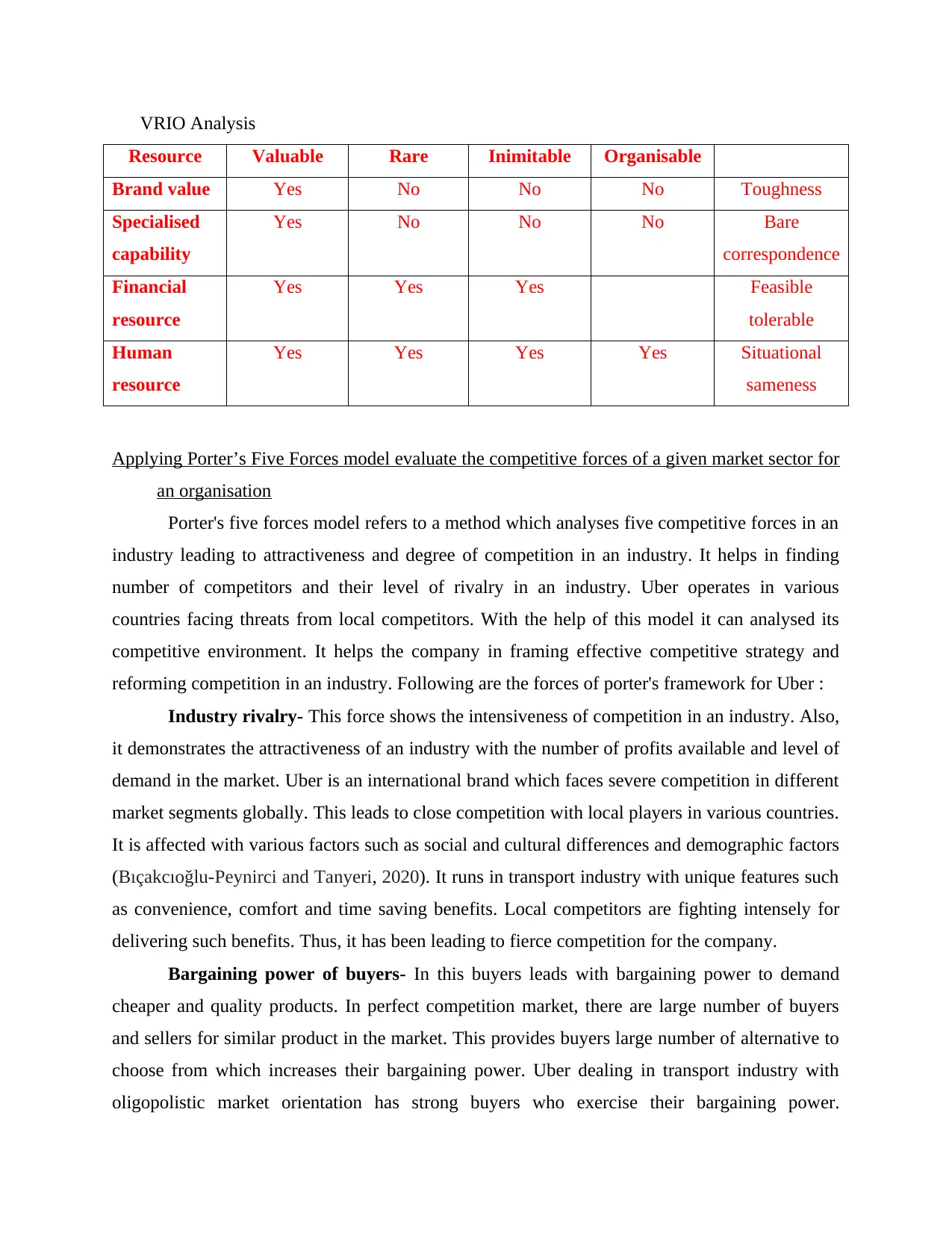
VRIO Analysis
Resource Valuable Rare Inimitable Organisable
Brand value Yes No No No Toughness
Specialised
capability
Yes No No No Bare
correspondence
Financial
resource
Yes Yes Yes Feasible
tolerable
Human
resource
Yes Yes Yes Yes Situational
sameness
Applying Porter’s Five Forces model evaluate the competitive forces of a given market sector for
an organisation
Porter's five forces model refers to a method which analyses five competitive forces in an
industry leading to attractiveness and degree of competition in an industry. It helps in finding
number of competitors and their level of rivalry in an industry. Uber operates in various
countries facing threats from local competitors. With the help of this model it can analysed its
competitive environment. It helps the company in framing effective competitive strategy and
reforming competition in an industry. Following are the forces of porter's framework for Uber :
Industry rivalry- This force shows the intensiveness of competition in an industry. Also,
it demonstrates the attractiveness of an industry with the number of profits available and level of
demand in the market. Uber is an international brand which faces severe competition in different
market segments globally. This leads to close competition with local players in various countries.
It is affected with various factors such as social and cultural differences and demographic factors
(Bıçakcıoğlu-Peynirci and Tanyeri, 2020). It runs in transport industry with unique features such
as convenience, comfort and time saving benefits. Local competitors are fighting intensely for
delivering such benefits. Thus, it has been leading to fierce competition for the company.
Bargaining power of buyers- In this buyers leads with bargaining power to demand
cheaper and quality products. In perfect competition market, there are large number of buyers
and sellers for similar product in the market. This provides buyers large number of alternative to
choose from which increases their bargaining power. Uber dealing in transport industry with
oligopolistic market orientation has strong buyers who exercise their bargaining power.
Resource Valuable Rare Inimitable Organisable
Brand value Yes No No No Toughness
Specialised
capability
Yes No No No Bare
correspondence
Financial
resource
Yes Yes Yes Feasible
tolerable
Human
resource
Yes Yes Yes Yes Situational
sameness
Applying Porter’s Five Forces model evaluate the competitive forces of a given market sector for
an organisation
Porter's five forces model refers to a method which analyses five competitive forces in an
industry leading to attractiveness and degree of competition in an industry. It helps in finding
number of competitors and their level of rivalry in an industry. Uber operates in various
countries facing threats from local competitors. With the help of this model it can analysed its
competitive environment. It helps the company in framing effective competitive strategy and
reforming competition in an industry. Following are the forces of porter's framework for Uber :
Industry rivalry- This force shows the intensiveness of competition in an industry. Also,
it demonstrates the attractiveness of an industry with the number of profits available and level of
demand in the market. Uber is an international brand which faces severe competition in different
market segments globally. This leads to close competition with local players in various countries.
It is affected with various factors such as social and cultural differences and demographic factors
(Bıçakcıoğlu-Peynirci and Tanyeri, 2020). It runs in transport industry with unique features such
as convenience, comfort and time saving benefits. Local competitors are fighting intensely for
delivering such benefits. Thus, it has been leading to fierce competition for the company.
Bargaining power of buyers- In this buyers leads with bargaining power to demand
cheaper and quality products. In perfect competition market, there are large number of buyers
and sellers for similar product in the market. This provides buyers large number of alternative to
choose from which increases their bargaining power. Uber dealing in transport industry with
oligopolistic market orientation has strong buyers who exercise their bargaining power.
⊘ This is a preview!⊘
Do you want full access?
Subscribe today to unlock all pages.

Trusted by 1+ million students worldwide
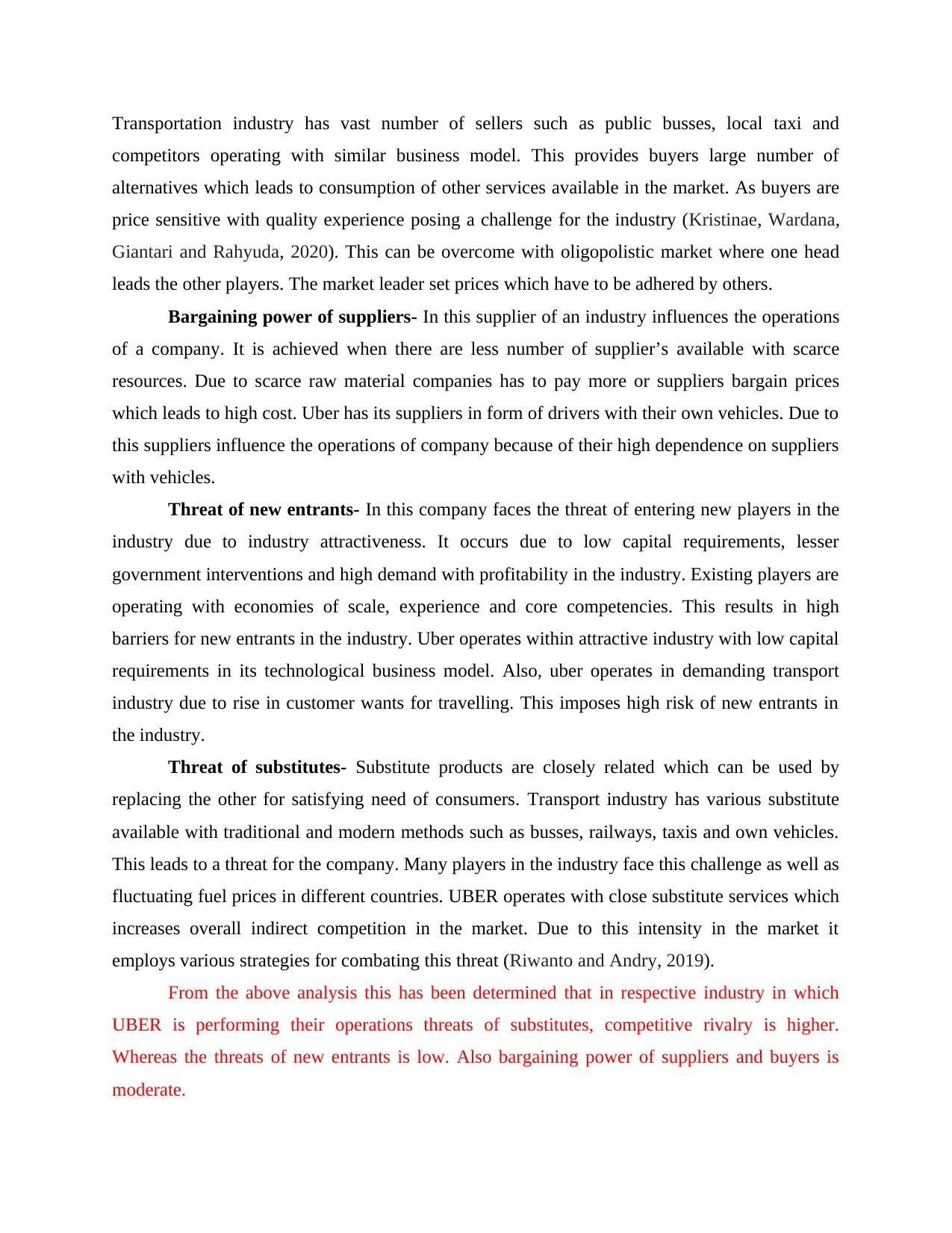
Transportation industry has vast number of sellers such as public busses, local taxi and
competitors operating with similar business model. This provides buyers large number of
alternatives which leads to consumption of other services available in the market. As buyers are
price sensitive with quality experience posing a challenge for the industry (Kristinae, Wardana,
Giantari and Rahyuda, 2020). This can be overcome with oligopolistic market where one head
leads the other players. The market leader set prices which have to be adhered by others.
Bargaining power of suppliers- In this supplier of an industry influences the operations
of a company. It is achieved when there are less number of supplier’s available with scarce
resources. Due to scarce raw material companies has to pay more or suppliers bargain prices
which leads to high cost. Uber has its suppliers in form of drivers with their own vehicles. Due to
this suppliers influence the operations of company because of their high dependence on suppliers
with vehicles.
Threat of new entrants- In this company faces the threat of entering new players in the
industry due to industry attractiveness. It occurs due to low capital requirements, lesser
government interventions and high demand with profitability in the industry. Existing players are
operating with economies of scale, experience and core competencies. This results in high
barriers for new entrants in the industry. Uber operates within attractive industry with low capital
requirements in its technological business model. Also, uber operates in demanding transport
industry due to rise in customer wants for travelling. This imposes high risk of new entrants in
the industry.
Threat of substitutes- Substitute products are closely related which can be used by
replacing the other for satisfying need of consumers. Transport industry has various substitute
available with traditional and modern methods such as busses, railways, taxis and own vehicles.
This leads to a threat for the company. Many players in the industry face this challenge as well as
fluctuating fuel prices in different countries. UBER operates with close substitute services which
increases overall indirect competition in the market. Due to this intensity in the market it
employs various strategies for combating this threat (Riwanto and Andry, 2019).
From the above analysis this has been determined that in respective industry in which
UBER is performing their operations threats of substitutes, competitive rivalry is higher.
Whereas the threats of new entrants is low. Also bargaining power of suppliers and buyers is
moderate.
competitors operating with similar business model. This provides buyers large number of
alternatives which leads to consumption of other services available in the market. As buyers are
price sensitive with quality experience posing a challenge for the industry (Kristinae, Wardana,
Giantari and Rahyuda, 2020). This can be overcome with oligopolistic market where one head
leads the other players. The market leader set prices which have to be adhered by others.
Bargaining power of suppliers- In this supplier of an industry influences the operations
of a company. It is achieved when there are less number of supplier’s available with scarce
resources. Due to scarce raw material companies has to pay more or suppliers bargain prices
which leads to high cost. Uber has its suppliers in form of drivers with their own vehicles. Due to
this suppliers influence the operations of company because of their high dependence on suppliers
with vehicles.
Threat of new entrants- In this company faces the threat of entering new players in the
industry due to industry attractiveness. It occurs due to low capital requirements, lesser
government interventions and high demand with profitability in the industry. Existing players are
operating with economies of scale, experience and core competencies. This results in high
barriers for new entrants in the industry. Uber operates within attractive industry with low capital
requirements in its technological business model. Also, uber operates in demanding transport
industry due to rise in customer wants for travelling. This imposes high risk of new entrants in
the industry.
Threat of substitutes- Substitute products are closely related which can be used by
replacing the other for satisfying need of consumers. Transport industry has various substitute
available with traditional and modern methods such as busses, railways, taxis and own vehicles.
This leads to a threat for the company. Many players in the industry face this challenge as well as
fluctuating fuel prices in different countries. UBER operates with close substitute services which
increases overall indirect competition in the market. Due to this intensity in the market it
employs various strategies for combating this threat (Riwanto and Andry, 2019).
From the above analysis this has been determined that in respective industry in which
UBER is performing their operations threats of substitutes, competitive rivalry is higher.
Whereas the threats of new entrants is low. Also bargaining power of suppliers and buyers is
moderate.
Paraphrase This Document
Need a fresh take? Get an instant paraphrase of this document with our AI Paraphraser
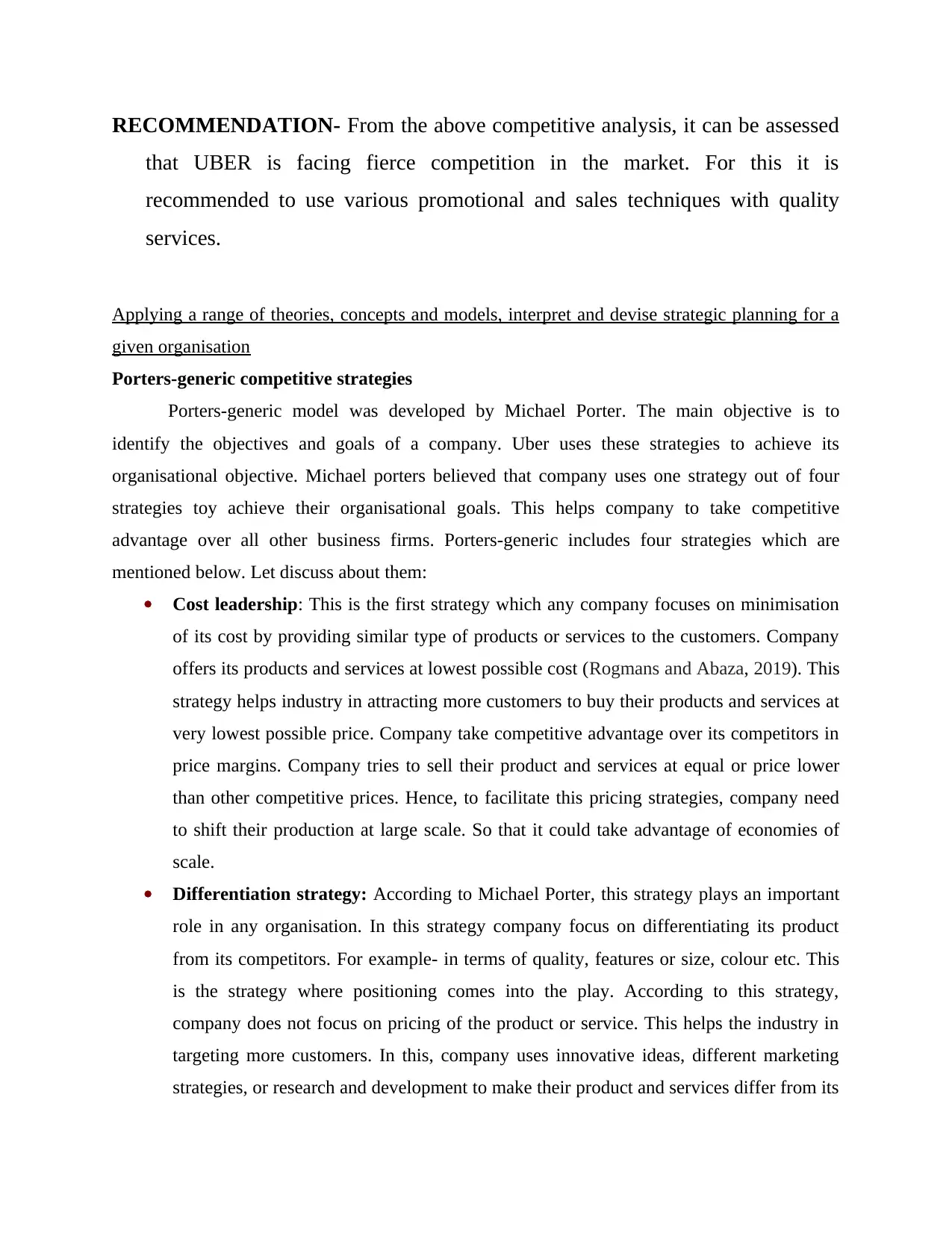
RECOMMENDATION- From the above competitive analysis, it can be assessed
that UBER is facing fierce competition in the market. For this it is
recommended to use various promotional and sales techniques with quality
services.
Applying a range of theories, concepts and models, interpret and devise strategic planning for a
given organisation
Porters-generic competitive strategies
Porters-generic model was developed by Michael Porter. The main objective is to
identify the objectives and goals of a company. Uber uses these strategies to achieve its
organisational objective. Michael porters believed that company uses one strategy out of four
strategies toy achieve their organisational goals. This helps company to take competitive
advantage over all other business firms. Porters-generic includes four strategies which are
mentioned below. Let discuss about them:
Cost leadership: This is the first strategy which any company focuses on minimisation
of its cost by providing similar type of products or services to the customers. Company
offers its products and services at lowest possible cost (Rogmans and Abaza, 2019). This
strategy helps industry in attracting more customers to buy their products and services at
very lowest possible price. Company take competitive advantage over its competitors in
price margins. Company tries to sell their product and services at equal or price lower
than other competitive prices. Hence, to facilitate this pricing strategies, company need
to shift their production at large scale. So that it could take advantage of economies of
scale.
Differentiation strategy: According to Michael Porter, this strategy plays an important
role in any organisation. In this strategy company focus on differentiating its product
from its competitors. For example- in terms of quality, features or size, colour etc. This
is the strategy where positioning comes into the play. According to this strategy,
company does not focus on pricing of the product or service. This helps the industry in
targeting more customers. In this, company uses innovative ideas, different marketing
strategies, or research and development to make their product and services differ from its
that UBER is facing fierce competition in the market. For this it is
recommended to use various promotional and sales techniques with quality
services.
Applying a range of theories, concepts and models, interpret and devise strategic planning for a
given organisation
Porters-generic competitive strategies
Porters-generic model was developed by Michael Porter. The main objective is to
identify the objectives and goals of a company. Uber uses these strategies to achieve its
organisational objective. Michael porters believed that company uses one strategy out of four
strategies toy achieve their organisational goals. This helps company to take competitive
advantage over all other business firms. Porters-generic includes four strategies which are
mentioned below. Let discuss about them:
Cost leadership: This is the first strategy which any company focuses on minimisation
of its cost by providing similar type of products or services to the customers. Company
offers its products and services at lowest possible cost (Rogmans and Abaza, 2019). This
strategy helps industry in attracting more customers to buy their products and services at
very lowest possible price. Company take competitive advantage over its competitors in
price margins. Company tries to sell their product and services at equal or price lower
than other competitive prices. Hence, to facilitate this pricing strategies, company need
to shift their production at large scale. So that it could take advantage of economies of
scale.
Differentiation strategy: According to Michael Porter, this strategy plays an important
role in any organisation. In this strategy company focus on differentiating its product
from its competitors. For example- in terms of quality, features or size, colour etc. This
is the strategy where positioning comes into the play. According to this strategy,
company does not focus on pricing of the product or service. This helps the industry in
targeting more customers. In this, company uses innovative ideas, different marketing
strategies, or research and development to make their product and services differ from its
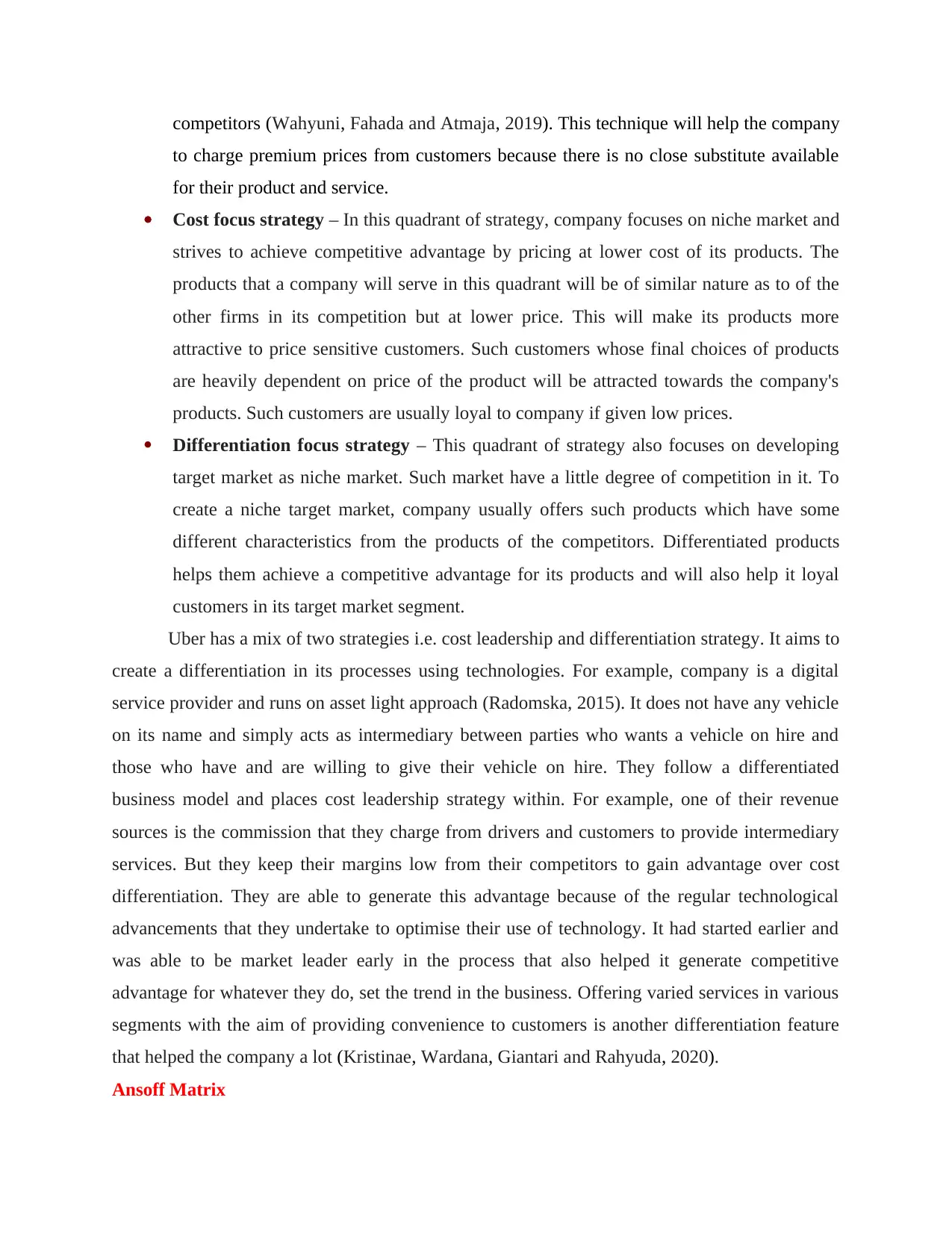
competitors (Wahyuni, Fahada and Atmaja, 2019). This technique will help the company
to charge premium prices from customers because there is no close substitute available
for their product and service.
Cost focus strategy – In this quadrant of strategy, company focuses on niche market and
strives to achieve competitive advantage by pricing at lower cost of its products. The
products that a company will serve in this quadrant will be of similar nature as to of the
other firms in its competition but at lower price. This will make its products more
attractive to price sensitive customers. Such customers whose final choices of products
are heavily dependent on price of the product will be attracted towards the company's
products. Such customers are usually loyal to company if given low prices.
Differentiation focus strategy – This quadrant of strategy also focuses on developing
target market as niche market. Such market have a little degree of competition in it. To
create a niche target market, company usually offers such products which have some
different characteristics from the products of the competitors. Differentiated products
helps them achieve a competitive advantage for its products and will also help it loyal
customers in its target market segment.
Uber has a mix of two strategies i.e. cost leadership and differentiation strategy. It aims to
create a differentiation in its processes using technologies. For example, company is a digital
service provider and runs on asset light approach (Radomska, 2015). It does not have any vehicle
on its name and simply acts as intermediary between parties who wants a vehicle on hire and
those who have and are willing to give their vehicle on hire. They follow a differentiated
business model and places cost leadership strategy within. For example, one of their revenue
sources is the commission that they charge from drivers and customers to provide intermediary
services. But they keep their margins low from their competitors to gain advantage over cost
differentiation. They are able to generate this advantage because of the regular technological
advancements that they undertake to optimise their use of technology. It had started earlier and
was able to be market leader early in the process that also helped it generate competitive
advantage for whatever they do, set the trend in the business. Offering varied services in various
segments with the aim of providing convenience to customers is another differentiation feature
that helped the company a lot (Kristinae, Wardana, Giantari and Rahyuda, 2020).
Ansoff Matrix
to charge premium prices from customers because there is no close substitute available
for their product and service.
Cost focus strategy – In this quadrant of strategy, company focuses on niche market and
strives to achieve competitive advantage by pricing at lower cost of its products. The
products that a company will serve in this quadrant will be of similar nature as to of the
other firms in its competition but at lower price. This will make its products more
attractive to price sensitive customers. Such customers whose final choices of products
are heavily dependent on price of the product will be attracted towards the company's
products. Such customers are usually loyal to company if given low prices.
Differentiation focus strategy – This quadrant of strategy also focuses on developing
target market as niche market. Such market have a little degree of competition in it. To
create a niche target market, company usually offers such products which have some
different characteristics from the products of the competitors. Differentiated products
helps them achieve a competitive advantage for its products and will also help it loyal
customers in its target market segment.
Uber has a mix of two strategies i.e. cost leadership and differentiation strategy. It aims to
create a differentiation in its processes using technologies. For example, company is a digital
service provider and runs on asset light approach (Radomska, 2015). It does not have any vehicle
on its name and simply acts as intermediary between parties who wants a vehicle on hire and
those who have and are willing to give their vehicle on hire. They follow a differentiated
business model and places cost leadership strategy within. For example, one of their revenue
sources is the commission that they charge from drivers and customers to provide intermediary
services. But they keep their margins low from their competitors to gain advantage over cost
differentiation. They are able to generate this advantage because of the regular technological
advancements that they undertake to optimise their use of technology. It had started earlier and
was able to be market leader early in the process that also helped it generate competitive
advantage for whatever they do, set the trend in the business. Offering varied services in various
segments with the aim of providing convenience to customers is another differentiation feature
that helped the company a lot (Kristinae, Wardana, Giantari and Rahyuda, 2020).
Ansoff Matrix
⊘ This is a preview!⊘
Do you want full access?
Subscribe today to unlock all pages.

Trusted by 1+ million students worldwide
1 out of 15
Related Documents
Your All-in-One AI-Powered Toolkit for Academic Success.
+13062052269
info@desklib.com
Available 24*7 on WhatsApp / Email
![[object Object]](/_next/static/media/star-bottom.7253800d.svg)
Unlock your academic potential
Copyright © 2020–2025 A2Z Services. All Rights Reserved. Developed and managed by ZUCOL.





